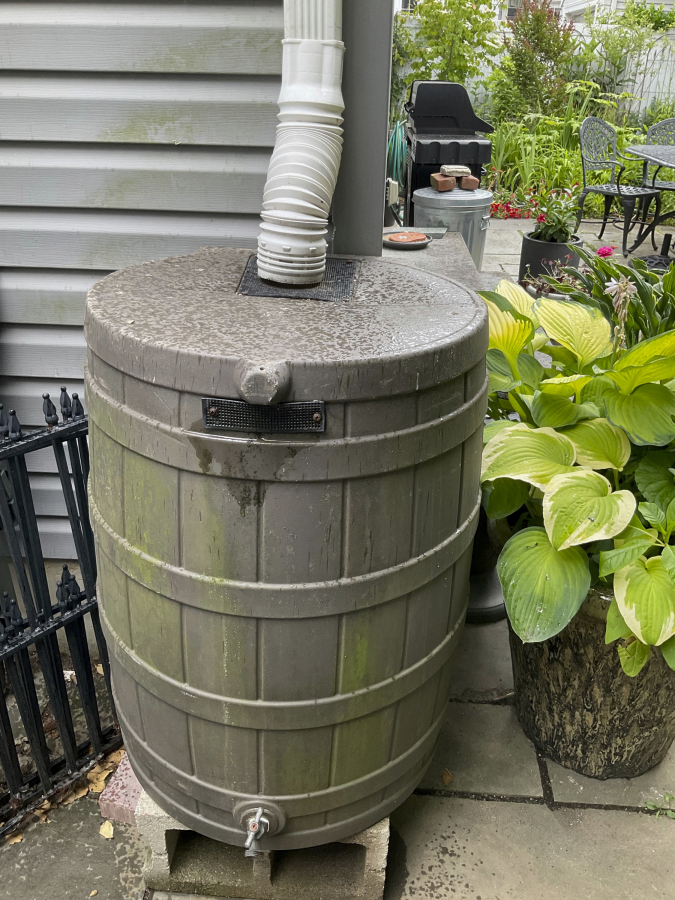Until I installed soaker hoses throughout my vegetable beds this year, I’d always watered my plants by hand, which over the years had become tiresome.
Standing outside holding a garden hose wasn’t exactly my idea of a good time, but it directs water precisely to the soil above roots, making sure it lands where it’s needed. That eliminates waste, and goes a long way toward preventing diseases like powdery mildew. That’s good for plants, the environment and the water bill.
Placing flexible, porous rubber or fabric soaker hoses on the soil around plants is another preferred way to irrigate, as it allows water to seep slowly over roots. Drip irrigation hoses (rigid tubes with emitter holes that drip or stream water) work similarly.
There are plenty of other easy ways to save water around the garden.
When to water, and how deeply
Applying water in the morning, for instance, allows time for it to permeate deeply into the soil before the sun gets too hot. Wait until later in the day, and a good portion of that water will evaporate from the soil surface before doing its job. Later still, and moisture could stick around overnight, risking mold, mildew and fungal diseases.
How you water is just as important as when. Giving plants a quick, daily sprinkle offers little if any benefit to roots, which, depending on the plant, could extend a foot or more into the soil. Instead, water less frequently but deeply.
And when the soil is really dry, it’s even more important to slow down, or the water will run off without penetrating the surface, just as a bone-dry kitchen sponge has difficulty absorbing a spill.
Capture, reuse water
You can recycle water from boiling pasta, vegetables and eggs instead of pouring it down the drain, as long as it hasn’t been salted. Water from dehumidifiers can be used, too. Waste not, want not.
Redirect a downspout to fill a rain barrel, then use the captured water to fill watering cans. Or use an adapter to attach a garden or soaker hose to the spigot hole at the bottom of the barrel.
Some plants are thirstier than other
When planting a garden, we typically give thought to what looks good with what and (hopefully) each plant’s sunlight requirements. Consider water needs, too, so as not to overwater drought-resistant plants when trying to appease thirsty water hogs nearby.
For the same reason, it’s a good idea to keep lawns separate from trees, shrubs, groundcovers, perennials and annuals if you use an automatic sprinkler system, which, by the way, wets the foliage of plants in the path of the spray, making them susceptible to disease.
Better yet, use native plants, most of which are drought-tolerant. They’ll need regular watering during their first year or two, but once they’re established, they can typically get by on rainwater alone, except maybe during prolonged heat waves. To find plants native to your area, plug your zip code into the online databases at The National Wildlife Federation (https://www.nwf.org/NativePlantFinder/Plants) and Audubon Society (https://www.audubon.org/native-plants) websites.
Hold in moisture
When planting in the garden, incorporate a generous amount of compost into holes to increase the water-holding capacity of sandy soil and improve drainage in clay.
Apply 2 to 3 inches of mulch around trees, shrubs and plants to retain soil moisture, reduce surface evaporation and inhibit weeds. Wait until the soil warms up before mulching, and keep the material a few inches away from stems and trunks.
When planting containers, look for a potting mix that includes vermiculite, a moisture-retaining mineral. Soil moisture polymer granules such as SoilMoist can also be added to reduce watering needs by as much as 50 percent.
You can even tear open a (clean!) baby diaper and mix the absorbent hydrogels with your potting mix, or simply place an unfolded diaper at the bottom of a container (plastic side down, with holes poked in for drainage) to absorb and hold moisture. Just don’t use any of these if your container includes succulents or other plants that require dry, well-draining soil.
Factor in rain
If you’re using an automatic sprinkler, set the timer for early in the morning, preferably just before dawn.
Look for a timer with a rain sensor, or manually override its programming to avoid waste on rainy days.
Most lawns need about 1 to 1 ½ inches of water per week, including from rain, but you won’t know how much your system puts out unless you test it. Set a tuna fish can on the lawn during a cycle, then measure the water accumulation in the can.
A rain gauge, which sort of looks like a test tube marked with measurements, will also inform on rainfall amounts.



